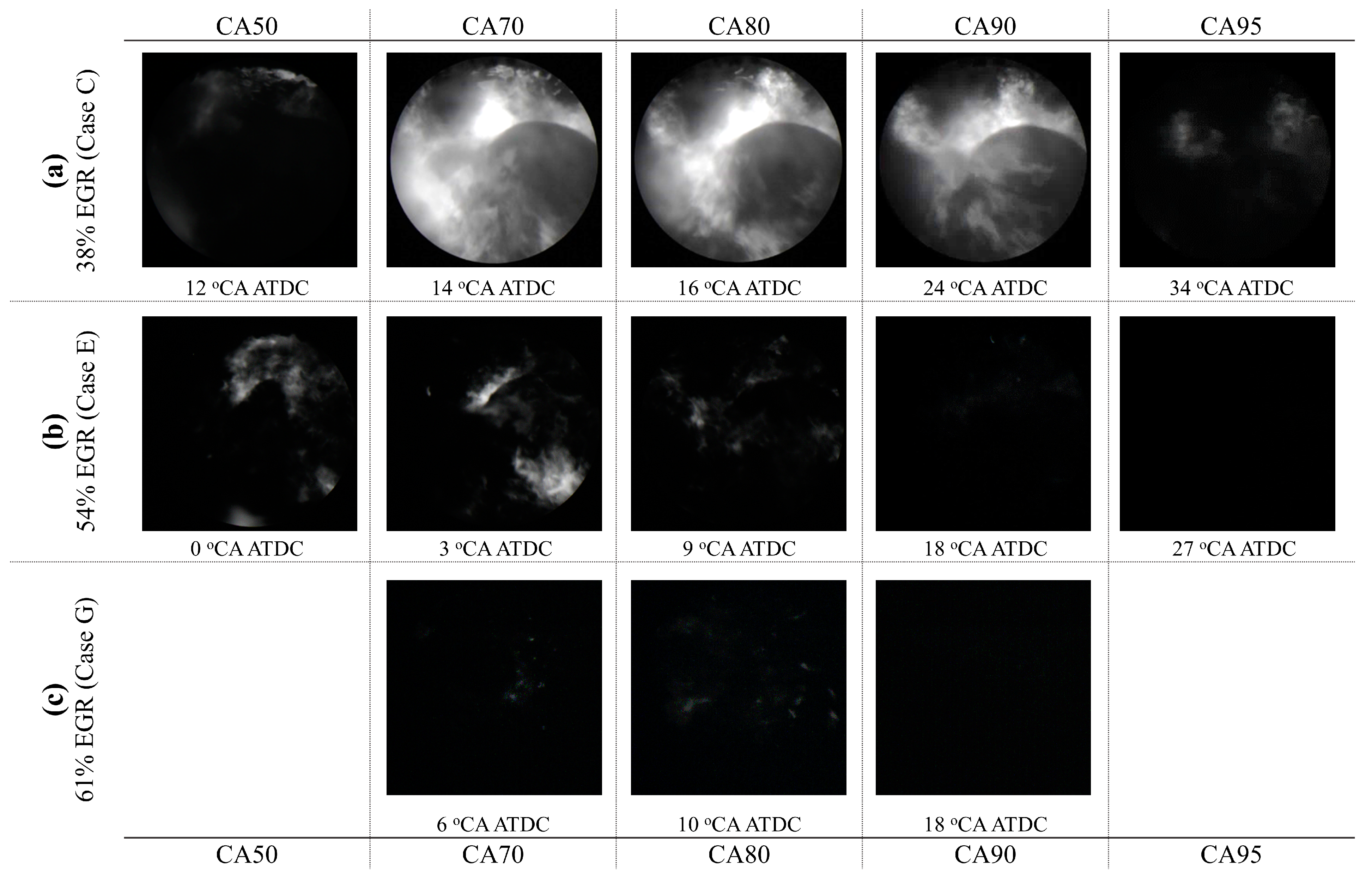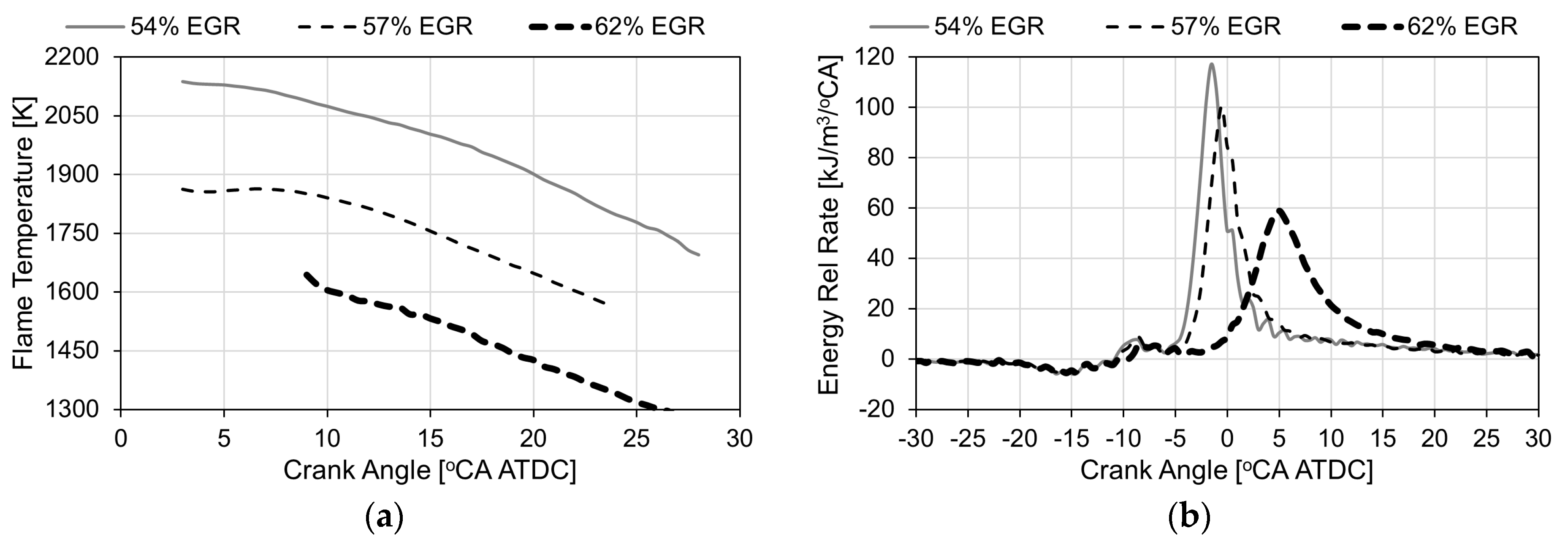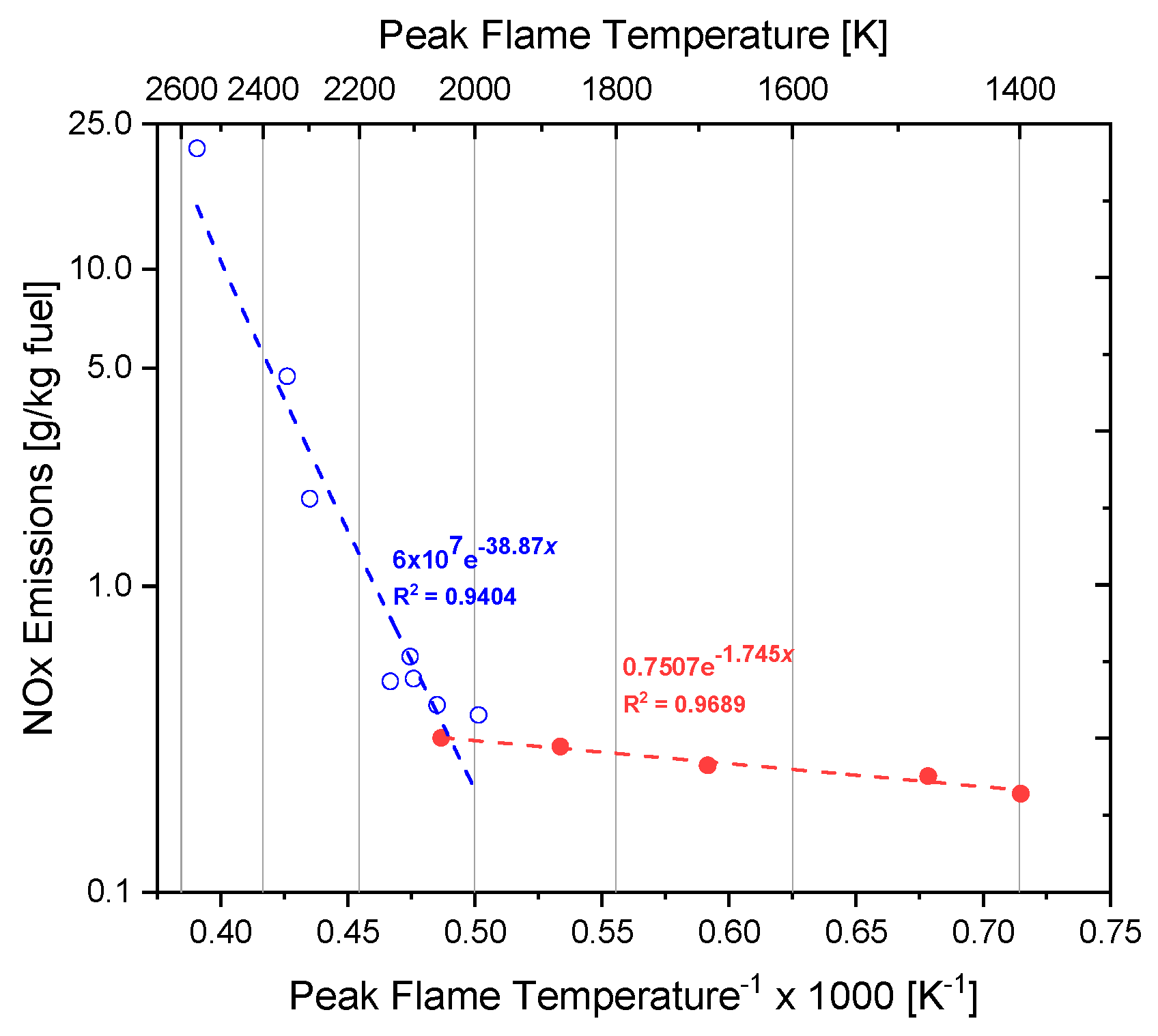The Impact of Fuel Injection Timing and Charge Dilution Rate on Low Temperature Combustion in a Compression Ignition Engine
Abstract
:1. Introduction
2. Experimental Apparatus
3. Results and Discussion
3.1. Comparison of Emissions and In-Cylinder Flame Temperature and KL Factor during a Transition from Conventional Diesel to High-EGR LTC
3.2. Comparison of Performance, Emissions and In-Cylinder Flame Temperature to Minor Changes in EGR Rates at Constant SOI in High-EGR LTC
3.3. Comparison of Performance, Emissions and In-Cylinder Flame Temperature to Changes in SOI Timings at Constant EGR Rate in High-EGR LTC
3.4. Spray Impingement on Piston Lip/Impingement in the Squish Region
3.5. Kinetic Parameters of NOx Formation with EGR Dilution
4. Conclusions
- The measurement of in-cylinder flame temperatures during transition from conventional diesel to high-dilution LTC indicated that flame temperature decreased monotonically even though the SOI was advanced to enhance the combustion. At low load (300 kPa gross IMEP), LTC—as defined by simultaneous low smoke and low NOx levels—was achieved at ~54% EGR (~14% intake oxygen mass fraction).
- At intermediate EGR levels (47% EGR, ~17.4%), advanced injection timing (−9 °CA ATDC) led to in-cylinder temperatures similar to the less dilute CDC case (38% EGR—~19.2%), but with an equivalent ignition delay and lower oxygen content. This led to higher soot formation with limited subsequent soot oxidation, resulting in the highest measured in-cylinder KL factor and engine-out soot emissions.
- At the onset of LTC (corresponding to 54% EGR level—~15%), an optimal injection timing window can be observed between −18 and −24 °CA ATDC. This region includes relatively low emissions of PM, THC and CO as well as minimized GISFC and good combustion stability (COV of IMEP < 2%). The two-colour pyrometry measurements indicate a long-duration combustion event with durations of 20 °CA or more where in-cylinder temperatures are sufficient (>1800 K) to oxidize partial combustion products.
- With LTC, advancing the injection provides longer premixing before start of combustion, leading to improved combustion performance. The degree of advance is limited by the need to avoid the diesel spray impinging on the piston lip or squish region. This impingement leads to poor combustion, low thermal efficiency and high combustion by-product emissions.
- NOx emissions correlate well with the peak flame temperature. The activation energy value quantified using engine-out Nox concentrations and measured peak flame temperatures for low to moderate dilution levels, agrees well with the value reported in previous literature. At higher dilution levels (once LTC is achieved), the NOx-peak flame temperature correlation exhibited a lower activation energy and a lower pre-exponential factor which is several orders of magnitudes lower than that of high flame temperatures, indicating a much lower sensitivity of NOx to peak flame temperature at low intake oxygen mass fractions.
- At retarded SOI, the retarded occurrence of peak flame temperature and shorter residence time of high flame temperature are responsible for the combustion instability and bulk quenching which leads to high THC and CO emissions in the high-dilution LTC strategy. With advanced SOI, the peak flame temperature is advanced towards TDC which leads to reduced degree to bulk quenching and hence, lower THC and CO emissions and lower cyclic variability.
- When the timing is advanced beyond −24 °CA ATDC, the flame temperature drops very quickly in the high-dilution LTC strategy. This is a result of spray impingement on the piston lip or a large part of the spray missing the piston bowl. This would likely lead to an over-lean mixture in the piston bowl with rich pockets in the squish region leading to poor combustion in the partially premixed combustion conditions. This leads to a rapid reduction in the flame temperature and increases the smoke, THC and CO emissions and combustion variability.
Author Contributions
Funding
Data Availability Statement
Acknowledgments
Conflicts of Interest
Abbreviations
| ATDC | After top dead centre |
| °CA | Degree crank angle |
| CA10 | 10% of cumulative energy release |
| CA50 | Mid-point of cumulative energy release |
| CA70, CA80 | 70% and 80% of cumulative energy release, respectively |
| CA90 | 90% of cumulative energy release |
| CA95 | 95% of cumulative energy release |
| CCD | Charge coupled device |
| CDC | Conventional diesel combustion |
| CO | Carbon monoxide |
| CO2 | Carbon dioxide |
| COV | Coefficient of variation |
| E0 | Activation energy |
| EGR | Exhaust gas recirculation |
| FOV | Field of view |
| FSN | Filter smoke number |
| GIMEP | Gross indicated mean effective pressure |
| GISFC | Gross indicated specific fuel consumption |
| KL | Soot absorption coefficient (K) and optical path length (L): an indicator of soot concentration [μm1.39] |
| LTC | Low temperature combustion |
| LTR | Low temperature reaction |
| MBT | Maximum advance for best torque |
| NOX | Oxides of nitrogen (NO and NO2) |
| N2O | Nitrous oxide |
| PM | Particulate matter |
| PMT | Photomultiplier tube |
| R0 | Universal gas constant |
| RCCI | Reactivity-controlled compression ignition |
| SCR | Selective catalytic reduction |
| SOC | Start of combustion |
| SOI | Start of injection |
| TDC | Top dead centre |
| THC | Total unburned hydrocarbons (C1) |
| Intake oxygen mass fraction (%) |
References
- Ladommatos, N.; Abdelhalim, S.; Zhao, H. The effects of exhaust gas recirculation on diesel combustion and emissions. Int. J. Engine Res. 2000, 1, 107–126. [Google Scholar] [CrossRef]
- Lambert, C.K. Perspective on SCR NOx control for diesel vehicles. React. Chem. Eng. 2019, 4, 969–974. [Google Scholar] [CrossRef]
- Joshi, A. Review of vehicle engine efficiency and emissions. SAE Int. Jn. Adv. Curr. Pract. Mobil. 2019, 1, 734–761. [Google Scholar]
- Conway, G.; Joshi, A.; Leach, F.; Garcia, A.; Senecal, P.K. A review of current and future powertrain technologies and trends in 2020. Transp. Eng. 2021, 5, 100080. [Google Scholar] [CrossRef]
- Boger, T.; Rose, D.; He, S.; Joshi, A. Developments for future EU7 regulations and the path to zero impact emissions—A catalyst substrate and filter supplier’s perspective. Transp. Eng. 2022, 10, 100129. [Google Scholar] [CrossRef]
- Sarangi, A.K.; Garner, C.P.; McTaggart-Cowan, G.P.; Davy, M.H.; Wahab, E.; Peckham, M. Managing the transition between low temperature combustion and conventional diesel combustion during a load change. In Proceedings of the ASME Internal Combustion Engine Division Fall Technical Conference, Vancouver, BC, Canada, 23–26 September 2012; pp. 243–255, Paper No. ICEF2012-92049. [Google Scholar]
- Sarangi, A.K.; Garner, C.P.; McTaggart-Cowan, G.P.; Davy, M.H.; Wahab, E.; Peckham, M. Load transient between conventional diesel operation and low-temperature combustion. IMechE Part D J. Automob. Eng. 2015, 229, 850–865. [Google Scholar] [CrossRef] [Green Version]
- Han, S.; Bae, C.; Choi, S.B. Effects of operating parameters on mode transition between low-temperature combustion and conventional combustion in a light-duty diesel engine. Int. J. Engine Res. 2012, 14, 231–246. [Google Scholar] [CrossRef]
- Carlucci, A.P.; Laforgia, D.; Motz, S.; Wenzel, S.P. Advanced closed loop combustion control of a LTC diesel engine based on in-cylinder pressure signals. Energy Convers. Manag. 2014, 77, 193–207. [Google Scholar] [CrossRef]
- Paykani, A.; Garcia, A.; Shahbakhti, M.; Rahnama, P.; Reitz, R.D. Reactivity controlled compression ignition engine: Pathways towards commercial viability. Appl. Energy 2021, 282, 116174. [Google Scholar] [CrossRef]
- Agarwal, A.K.; Singh, A.P.; Garcia, A.; Monsalve-Serrano, J. Challenges and opportunities for application of reactivity-controlled compression ignition combustion in commercially viable transport engines. Prog. Energy Combust. Sci. 2022, 93, 101028. [Google Scholar] [CrossRef]
- Lee, J.; Chu, S.; Lim, D.; Jung, H.; Chi, Y.; Min, K. Comparison of combustion and emission characteristics under single-fueled and dual-fueled conditions with premixed compression ignition. Energy 2022, 241, 122855. [Google Scholar] [CrossRef]
- Sogbesan, O.; Garner, C.P.; Davy, M.H. The effects of increasing FAME biodiesel content on combustion characteristics and HC emissions in high-EGR low temperature combustion. Fuel 2021, 302, 121055. [Google Scholar] [CrossRef]
- Ma, Q.; Zhang, Q.; Zheng, Z. An experimental assessment on low temperature combustion using diesel/biodiesel/C2, C5 alcohol blends in a diesel engine. Fuel 2021, 288, 119832. [Google Scholar] [CrossRef]
- Agarwal, A.K.; Singh, A.P.; Maurya, R.K. Evolution, challenges and path forward for low temperature combustion engines. Prog. Energy Combust. Sci. 2017, 61, 1–56. [Google Scholar] [CrossRef]
- Cong, S.; McTaggart-Cowan, G.; Garner, C. Effects of Fuel Injection Parameters on Low Temperature Diesel Combustion Stability; SAE Paper No. 2010-01-0611; SAE International: Warrendale, PA, USA, 2010. [Google Scholar]
- Bittle, J.; Zheng, J.; Xue, X.; Song, H.; Jacobs, T. Cylinder-to-cylinder variation sources in diesel low temperature combustion and the influence they have on emissions. Int. J. Engine Res. 2014, 15, 112–122. [Google Scholar] [CrossRef]
- Han, S.; Kim, J.; Bae, C. Effect of air-fuel mixing quality on characteristics of conventional and low temperature diesel combustion. Appl. Energy 2014, 119, 454–466. [Google Scholar] [CrossRef]
- Jung, Y.; Park, S.S.; Bae, C. Effects of oxygen concentration on highly diluted charge compression ignition combustion in a diesel engine. Appl. Therm. Eng. 2015, 90, 538–550. [Google Scholar] [CrossRef]
- Ogawa, H.; Morita, A.; Futagami, K.; Shibata, G. Ignition delays in diesel combustion and intake gas conditions. Int. J. Engine Res. 2018, 19, 805–812. [Google Scholar] [CrossRef]
- Inaba, K.; Ojima, Y.; Masuko, Y.; Kobashi, Y.; Shibata, G.; Ogawa, H. Thermal efficiency improvement with super-charging and cooled exhaust gas recirculation in semi-premixed diesel combustion with a twin peak shaped heat release. Int. J. Engine Res. 2019, 20, 80–91. [Google Scholar] [CrossRef]
- Sarangi, A.K.; Garner, C.P.; McTaggart-Cowan, G.P.; Davy, M.H.; Wahab EPeckham, M. Effects of engine operating parameters on diesel low temperature combustion with split fuel injection. IMechE Part D J. Automob. Eng. 2012, 226, 1271–1286. [Google Scholar] [CrossRef]
- AVL List GmbH. Instruction Manual for Cylinder Head with Endoscopic Access for AVL 5402 Single Cylinder Research Engine No. 5402.055; AVL List GmbH: Graz, Austria, 2009. [Google Scholar]
- Sarangi, A.K.; McTaggart-Cowan, G.; Davy, M.H.; Kirchen, P.; Garner, C.P. Two-Colour Pyrometry Measurements of Low-Temperature Combustion Using Borescopic Imaging; SAE Paper No. 2021-01-0426; SAE International: Warrendale, PA, USA, 2021. [Google Scholar]
- Heywood, J.B. Internal Combustion Engines Fundamentals, 2nd ed.; McGraw Hill Book Company: Windsor, NJ, USA, 2018. [Google Scholar]
- Cong, S. An Experimental Study of Low Temperature Combustion in a Diesel Engine. Ph.D. Thesis, Loughborough University, Loughborough, UK, 2011. [Google Scholar]
- Sarangi, A.K. Diesel Low Temperature Combustion—An Experimental Study. Ph.D. Thesis, Loughborough University, Loughborough, UK, 2012. [Google Scholar]
- Sarangi, A.K.; McTaggart-Cowan, G.P.; Garner, C.P. The Effects of Intake Pressure on High EGR Low Temperature Diesel Engine Combustion; SAE Paper No. 2010-01-2145; SAE International: Warrendale, PA, USA, 2010. [Google Scholar]
- Warnatz, J.; Maas, U.; Dibble, R.W. Combustion Physical and Chemical Fundamentals, Modeling and Simulation, Experiments, Pollutant Formation, 4th ed.; Springer Publication: Berlin/Heidelberg, Germany, 2006. [Google Scholar]
- Yoshikawa, T.; Reitz, R.D. Development of an improved NOx reaction mechanism for low temperature diesel combustion modelling. SAE Int. J. Engines 2009, 1, 1105–1117. [Google Scholar] [CrossRef]
- Desantes, J.M.; Lopez, J.J.; Redon, P.; Arregle, J. Evaluation of the thermal NO formation mechanism under low temperature diesel combustion conditions. Int. J. Engine Res. 2012, 13, 531–539. [Google Scholar] [CrossRef]
- Miller, J.A.; Bowman, C.T. Mechanism and modeling of nitrogen chemistry in combustion. Prog. Energy Combust. Sci. 1989, 15, 287–338. [Google Scholar] [CrossRef]
- Sarangi, A.K.; Garner, C.P.; McTaggart-Cowan, G.P.; Davy, M.H.; Hargrave, G.K. The impact of intake pressure on high exhaust gas recirculation low-temperature compression ignition engine combustion using borescopic imaging. Int. J. Engine Res. 2021, 22, 2347–2361. [Google Scholar] [CrossRef]
- Hiroyasu, H.; Arai, M. Structures of fuel sprays in diesel engines. SAE Trans. 1990, 99, 1050–1061. [Google Scholar]
- Lavoie, G.A.; Heywood, J.B.; Keck, J.C. Experimental and theoretical investigation of nitric oxide formation in internal combustion engines. Combust. Sci. Technol. 1970, 1, 313–326. [Google Scholar] [CrossRef]
- Plee, S.L.; Ahmad, T.; Myers, J.P.; Faeth, G.M. Diesel NOx emissions-a simple correlation technique for intake air effects. In Proceedings of the 19th International Symposium on Combustion, Haifa, Israel, 8–13 August 1982; pp. 1495–1502. [Google Scholar]
- Kook, S.; Bae, C.; Miles, P.C.; Choi, D.; Pickett, L.M. The Influence of Charge Dilution and Injection Timing on Low-Temperature Diesel Combustion and Emissions; SAE Paper No. 2005-01-3837; SAE International: Warrendale, PA, USA, 2005. [Google Scholar]











| Research Engine | |
| Engine make | AVL 5402 Single cylinder diesel |
| Bore/Stroke | 85/90 mm |
| Connecting rod length | 148 mm |
| Swept volume | 0.51 litre |
| Compression ratio | 17.1:1 |
| Rated speed | 4200 rev.min−1 |
| Swirl ratio | 1.78 |
| Fuelling System | |
| Injection system | Bosch common rail |
| Maximum rail pressure | 135 MPa |
| Nozzle type | Valve covered orifice (VCO) |
| Number of holes/Diameter | 5/0.18 mm |
| Spray included angle | 142° |
| Fuel* | |
| Density at 15 °C | 840 kg.m−3 |
| Polycyclic aromatic hydrocarbon (PAH) | 9% |
| Cetane number | 52 |
| Sulphur content | 8 mg.kg−1 |
| Case | Injected Fuel Mass (mg/cycle) | Injection Pressure (MPa) | SOI Timing (°CA ATDC) | Exhaust Gas Temperature (°C) | |
|---|---|---|---|---|---|
| A | 8 | 65 | −3 | 22.8/4 | 187 |
| B | 8 | 65 | −3 | 20.7/28 | 190 |
| C | 8 | 65 | −3 | 19.1/38 | 197 |
| D | 8 | 65 | −9 | 17.4/47 | 185 |
| E | 8 | 65 | −21 | 15.2/54 | 183 |
| F | 8 | 65 | −21 | 14.7/57 | 177 |
| G | 8 | 65 | −24 | 12.9/61 | 178 |
| H | 8 | 65 | −27 | 12.3/62 | 175 |
| I | 8 | 65 | −27 | 11.5/64 | 182 |
| SOI (°CA ATDC) | Smoke (FSN) | NOx (g/kgfuel) | THC (g/kgfuel) | CO (g/kg fuel) | GISFC (g/kWh) | Ignition Delay (°CA) | CA50 (°CA ATDC) | |
|---|---|---|---|---|---|---|---|---|
| −21 | 15.2/54 | 0.08 | 0.49 | 34.8 | 80.5 | 207.5 | 15 | −0.5 |
| 14.7/57 | 0.03 | 0.30 | 36.5 | 92.5 | 205.5 | 15 | 0.5 | |
| 11.7/62 | 0.03 | 0.30 | 51.3 | 130.5 | 214.1 | 17 | 6.5 | |
| −24 | 15.2/54 | 0.08 | 0.50 | 35.6 | 73.1 | 199.0 | 17 | −2 |
| 13.8/57 | 0.10 | 0.27 | 37.9 | 87.4 | 208.5 | 17 | 0 | |
| 12.1/61 | 0.09 | 0.24 | 43.0 | 117.0 | 214.6 | 19 | 4 | |
| 11.5/64 | 0.08 | 0.22 | 48.7 | 132.7 | 224.2 | 19 | 6 |
| EGR (% vol.) | SOI (°CA ATDC) | NOx (g/kg fuel) | GIMEP (MPa) | COVGIMEP (%) | CA50 (°CA ATDC) | |
|---|---|---|---|---|---|---|
| 54 | −9 | 15.2 | 0.38 | 0.29 | 2.12 | 9 |
| −12 | 15.3 | 0.47 | 0.29 | 1.89 | 5.0 | |
| −15 | 15.3 | 0.43 | 0.29 | 2.08 | 2.5 | |
| −18 | 15.1 | 0.38 | 0.31 | 1.87 | 1.0 | |
| −21 | 15.2 | 0.49 | 0.30 | 1.90 | −0.5 | |
| −24 | 15.2 | 0.50 | 0.30 | 1.86 | −2.0 | |
| −27 | 15.1 | 0.59 | 0.30 | 1.99 | −3.0 | |
| −30 | 15.5 | 0.48 | 0.29 | 2.48 | −2.5 | |
| −33 | 16.4 | 0.29 | 0.22 | 3.65 | −1.0 | |
| 59 | −3 | 15.6 | 0.32 | 0.19 | 9.93 | 26.0 |
| −9 | 14.1 | 0.25 | 0.27 | 2.92 | 11.5 | |
| −15 | 13.5 | 0.34 | 0.33 | 2.32 | 5.5 | |
| −21 | 13.9 | 0.39 | 0.30 | 2.45 | 1.5 | |
| −24 | 13.7 | 0.36 | 0.30 | 2.15 | 1.0 | |
| 62 | −18 | 11.9 | 0.29 | 0.28 | 3.11 | 9.0 |
| −21 | 11.9 | 0.23 | 0.29 | 2.47 | 6.5 | |
| −24 | 11.9 | 0.24 | 0.29 | 2.39 | 4.5 | |
| −27 | 11.8 | 0.20 | 0.29 | 2.20 | 4.5 | |
| −30 | 12.5 | 0.20 | 0.27 | 3.50 | 4.0 | |
| −33 | 14.0 | 0.28 | 0.22 | 5.50 | 5.0 |
Disclaimer/Publisher’s Note: The statements, opinions and data contained in all publications are solely those of the individual author(s) and contributor(s) and not of MDPI and/or the editor(s). MDPI and/or the editor(s) disclaim responsibility for any injury to people or property resulting from any ideas, methods, instructions or products referred to in the content. |
© 2022 by the authors. Licensee MDPI, Basel, Switzerland. This article is an open access article distributed under the terms and conditions of the Creative Commons Attribution (CC BY) license (https://creativecommons.org/licenses/by/4.0/).
Share and Cite
Sarangi, A.K.; McTaggart-Cowan, G.P.; Garner, C.P. The Impact of Fuel Injection Timing and Charge Dilution Rate on Low Temperature Combustion in a Compression Ignition Engine. Energies 2023, 16, 139. https://doi.org/10.3390/en16010139
Sarangi AK, McTaggart-Cowan GP, Garner CP. The Impact of Fuel Injection Timing and Charge Dilution Rate on Low Temperature Combustion in a Compression Ignition Engine. Energies. 2023; 16(1):139. https://doi.org/10.3390/en16010139
Chicago/Turabian StyleSarangi, Asish K., Gordon P. McTaggart-Cowan, and Colin P. Garner. 2023. "The Impact of Fuel Injection Timing and Charge Dilution Rate on Low Temperature Combustion in a Compression Ignition Engine" Energies 16, no. 1: 139. https://doi.org/10.3390/en16010139






